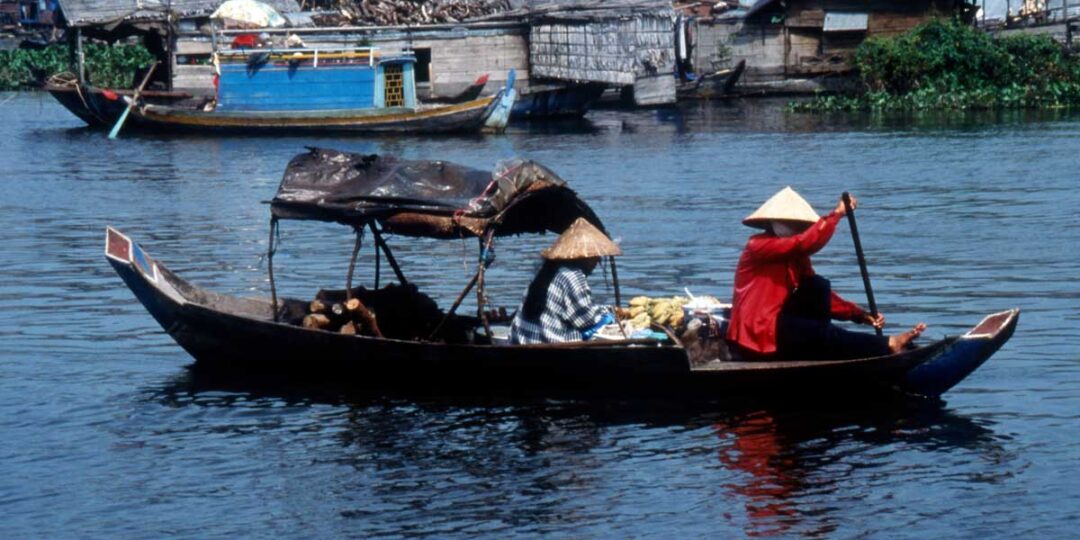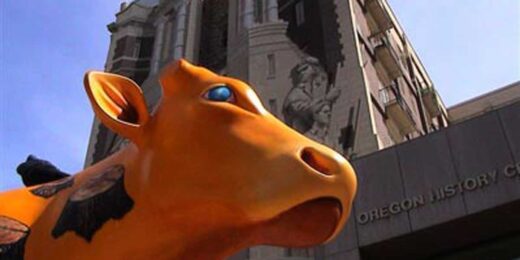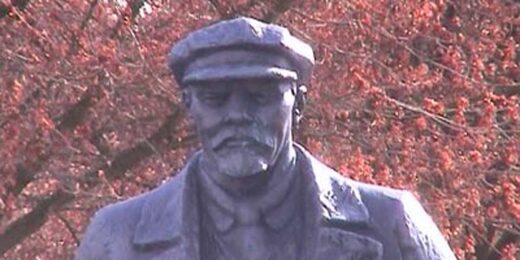Originally Published – Worldsurface.com, 25 Feb 2003
Sunrise. A paw-paw colored ball makes the sky smoky mauve and the tiny clouds burnt pink. The land and sea are the same temperature. There is no wind. The water is still. This is a place of two skies, the modest orange sun and its paint box sky reflected in the floodwaters of Tonle Sap Lake. The birds are hardly awake, but at the water’s edge there is a frenzy.
Most of the tourists here at this time have only one motive, to run the gauntlet of locals selling everything from egg baguettes to anti land mine t-shirts and climb onto the roof o a floating aeroplane fuselage without wings that will blast them across the lake and down the river to Phnom Penh. As they are shepherded past the merchants in their chequered krama they might get the idea that this part of Siem Reap is different from the Angkor temples they have clambered over for the last few days. As the boat engines roar to leave the floating village in its wake, a few photos of an upturned boat in a bamboo dry dock or a saffron robed monk under a black umbrella in a canoe are rattled off.
The great temple city of Angkor Wat is back on the tourist map. The Khmer Rouge is gone, the area has been cleared of land mines, and a few five star hotels now cater for the travelers who arrive after a 50-minute flight from Bangkok with another half dozen being built. Interest in the archaeological wonder has been fuelled by its use as a location for the 2001 film Tomb Raider (Check title), the aging stone walls held together by the giant root systems of jungle trees provided the perfect backdrop for cyber-babe Lara Croft’s adventures.
With over 70 temples in the area, visitors could take a week to see them all. Most however, spend just a few days before they experience temple fatigue and move on.
Thirty minutes south of Siem Reap and Angkor is Tonle Sap Lake. During the dry season, the lake covers 3, 000 square kilometers, however from May to October the Tonle Sap River flows backwards as the Mekong swells and the lake grows to over 8, 000 square kilometers. As well as providing a living for more than 40% of the population through fishing, the lake serves as an alternative to the decaying highways with plodding cargo barges and high-speed hydrofoils ferrying freight and people from Phnom Penh to northern ports.
The Tonle Sap provides not only an antidote to temple fatigue; it also gives extra insight for travelers into the strength and tradition of the Khmer empire. The Tonle Sap monsoon cycles had particular significance within the religion of the ancient Khmer. New Year is celebrated in the spring equinox. In March when the sun rises over Angkor’s central tower, the flows begin to fill the Tonle Sap, bringing rich fishing harvests that supported the Khmer. The ancient Bayon and Angkor temples depict in exquisite bas-relief how the life along the lake affected all walks of life.
To ensure access to the lake no matter where the shoreline is, the houses of the fishermen, who depend on the waters for their livlihood, are designed to float on the lake’s surface. Chong Khneas provides an excellent opportunity to experience the way these lakeside dwellers live. The village is home to 200 Khmer families, 250 Vietnamese familes and another 200 who are Muslim. In the still morning, the call to prayer sounds over loudspeakers scattering dozing cormorants. Everything floats. Students tie their canoes to the rail alongside the floating school. The campaign headquarters for the local politicians, the barber’s shop, the gambling dens and boat builders float. The floating barge markets sell local delicacies like Elephant fish, which has developed the ability to last for several hours out of water, in case the fast receding waters leave it stranded in the mud. The boats hang a sample of their wares on a pole to indicate what they are selling.
For US$ 10 you can get on a boat to putter through the impromptu gaps between houses. The boat moves slowly, a bit too fast to take decent photos, but it feels right to see a floating village this way. You can make up your own mind about getting off the boat at the tourist fish farm to see specially bred catfish, as well as a collared gibbon a caged porcupine and a python around a smiling girl’s neck. A few sick looking pelicans are chained in the sun for visitors to photograph here too.
Don’t limit your visit to what the boat guide points out to you. Some of the village can be explored on foot via thin roads that are inches above the waterline so ask your motorbike or car driver to give you some time to walk around. While you are strolling, drop in at the Gecko Environment Centre for further information about the environment, people and culture of the Tonle Sap.
In the wet season the village lies at the base of the only hill for miles, Phenom Krom. Shooting across Tonle Sap on an express boat, the hill is the only landmark above the water level as far as the eye can see, so a climb provides great views back towards Siem Reap and Angkor and over the vast lake. Three weathered ninth century towers dedicated to the Hindu deities, Shiva Vishnu and Shiva await you at the top of your 140-metre climb. From here, as the practising monks chant their prayers, you understand the ancient relationship between the stone towers of Angkor to the north and the life giving Tonle Sap.




No Comments